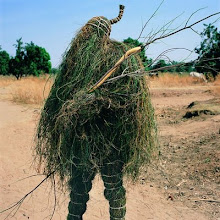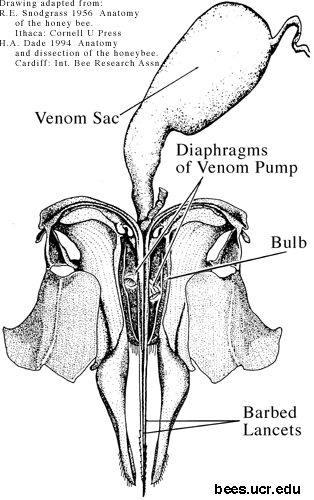April 30, 2011
Afterswarm
I went out to water the garden and noticed a swarm settling into a tree on our property line. My neighbor had told me he saw a swarm yesterday that flew right over his head and down the public staircase at the end of my block. "And then they took a hard right!" he said. They may have come from our Big Hive and this might be a little afterswarm.
The swarm located itself in a very hard to reach spot in this tree. We had to work really hard to get a ladder up there but finally we figured out a safe way to catch them and bring them down into the box we had set out for them.
A few of the bees fell into this Philadelphus shrub when we shook them out of the tree. By dark they had all flown into the hive to be with their queen. At least we THINK there is a queen. We'll see in a few days if there are any eggs.
April 26, 2011
A Bee C's
When I got back from my trip to Florida Charley called to let me know that he had seen a swarm at Church and 30th fly up into a tree as he was walking home from work. Could we get over there right now? Peter and I threw some tools and an empty box in my truck and met Charley at the corner. There they were, up in a pretty tall ficus tree, a nice big swarm.
Charley climbed up with a rope and some loppers. He swung the rope over a higher branch and then tied it to the branch the bees were clustered on while Peter and I set up the box and ladder below. He cut the branch and slowly lowered the branch, swarm and all, down to me on the ladder. Then I placed the branch on the waiting box and we watched the bees flood into the frames.
There was some question about whether we got the queen or not because a number of the bees flew right back up into the tree and settled back into a cluster. Others that had been knocked off the branch on the way down filed in an orderly fashion right into the front entrance to their new home.
Everything was going well and we thought we had about another 15 minutes to wrap things up. That's when the school buses pulled up. It was 3pm and school was out. All I could think was that some poor kid was going to get stung by accident and we would all get in trouble for collecting the swarm and causing a hazard.
There were a few nervous moments with the bus drivers but the kids got loaded on with no problems and off they went. The bees, however, were not so cooperative. There was still a bunch of them up in the tree so Charley climbed back in and shook them out. They landed all over the sidewalk and on the back of my truck.
The bus kept going by every few minutes with the windows down and gaping wide-eyed passengers staring at our project. Finally, we got most of the bees in the box and loaded them into my truck and carried them home to our apiary. It is a nice sized swarm and we are excited for a new addition.
April 24, 2011
Linda and Bruce's Bees
Linda has a house in a sweet little neighborhood called Smoky Hollow. This year she and Bruce decided to start keeping bees. They put a screen around the hives to keep a low profile in the neighborhood.
April 20, 2011
Henry's Bees
My buddy, Henry, decided to keep bees this year. He took to it like a fish to water. He has a hive at his mom's and another at his dad's house. When I went to visit I packed my beejacket and veil so I could have a look at his hives.
April 7, 2011
Removing bee stings - speed matters, method doesn't
Always good to know....
from: UC Riverside's Entemology page
(expanded from an article published 1996 in The Lancet 348:301-302)
Background Conventional advice on immediate treatment of honey bee stings has emphasized that the sting should be scraped off, never pinched. The morphology of the sting suggested no basis for this, and such advice is likely to slow down removal of the sting.
Methods The response to honey bee stings was assayed with a measurement of the size of the resulting sting weal. Injection of known quantities of venom demonstrated that this is a good measure of envenomization.
Findings Weal size, and thus envenomization, increased as the time from stinging to removal of the sting increased, even within a few seconds. There was no difference in the response to stings which were scraped or pinched off after two seconds.
Interpretation These data suggest that advice to patients on the immediate treatment of bee stings should emphasize quick removal, without concern regarding the method of removal
from: UC Riverside's Entemology page
(expanded from an article published 1996 in The Lancet 348:301-302)
Summary
Background Conventional advice on immediate treatment of honey bee stings has emphasized that the sting should be scraped off, never pinched. The morphology of the sting suggested no basis for this, and such advice is likely to slow down removal of the sting.
Methods The response to honey bee stings was assayed with a measurement of the size of the resulting sting weal. Injection of known quantities of venom demonstrated that this is a good measure of envenomization.
Findings Weal size, and thus envenomization, increased as the time from stinging to removal of the sting increased, even within a few seconds. There was no difference in the response to stings which were scraped or pinched off after two seconds.
Interpretation These data suggest that advice to patients on the immediate treatment of bee stings should emphasize quick removal, without concern regarding the method of removal
April 4, 2011
Mything Links: bees
While fooling around on the internet I found this nice homemade website full of all sorts of interesting bee related information and images by Kathleen Jenks, Ph.D. Sometimes sites like this just up and disappear so I decided to print it out for posterity and for my beekeeping library. As I scrolled through I figured it was about 15 pages of images and text but once I started printing it I realized my mistake. After 25 pages my printer ran out of paper. after 40 pages I ran out of yellow ink (damn you HP. Even though I am printing in black and white you won't finish this job till I replace the yellow cartridge.) I thiknk I am only about 3/4 of the way through. But I think it will be worth it once I get it all printed out. There are lots of images of bees and beekeeping in art, photos of the oldest bee, bees trapped in amber, stories of bees in folklore and legend. You know, a bee geeks dream come true.
MYTH*ING LINKS
An Annotated & Illustrated Collection of Worldwide Links to Mythologies,
Fairy Tales & Folklore, Sacred Arts & Sacred Traditions
by Kathleen Jenks, Ph.D.
An Annotated & Illustrated Collection of Worldwide Links to Mythologies,
Fairy Tales & Folklore, Sacred Arts & Sacred Traditions
by Kathleen Jenks, Ph.D.
COMMON THEMES, EAST & WEST:



IN THE  ORLD
ORLD
and
IN YTHOLOGY:
YTHOLOGY:
 ORLD
ORLD and
IN
 YTHOLOGY:
YTHOLOGY: ~~~~~~~~~~~~~~~~~
 EES
EES
 EES
EESApril 3, 2011
Bees Can Recognize Faces
If You Swat, Watch Out: Bees Remember Faces
By SINDYA N. BHANOO
Published: February 1, 2010
from The New York Times
A honeybee brain has a million neurons, compared with the 100 billion in a human brain. But, researchers report, bees can recognize faces, and they even do it the same way we do.
Bees and humans both use a technique called configural processing, piecing together the components of a face — eyes, ears, nose and mouth — to form a recognizable pattern, a team of researchers report in the Feb. 15 issue of The Journal of Experimental Biology.
“It’s a kind of gluing,” said Martin Giurfa, a professor of neural biology at the University de Toulouse, France, and one of the study’s authors.
It is the same ability, Dr. Giurfa said, that helps humans realize that a Chinese pagoda and a Swiss chalet are both abodes, based on their components.
“We know two vertical lines, with a hutlike top,” he said. “It’s a house.”
In their research, Dr. Giurfa and his colleagues created a display of hand-drawn images, some faces and some not.
The faces had bowls of sugar water in front of them, while the nonfaces were placed behind bowls containing plain water. After a few failed trips to the bowls without sugar water, the bees kept returning to the sugar-filled bowls in front of the faces, the scientists found.
The images and the bowls were cleaned after every visit, to ensure that the bees were using visual cues to find the sugar and not leaving scent marks.
The researchers found that bees could also distinguish a face that provided sugar water from one that did not.
After several hours’ training, the bees picked the right faces about 75 percent of the time, said Adrian Dyer, another author of the study and a vision scientist at Monash University in Australia.
The researchers said that while they were biologists and not computer scientists, they hoped their work could be more widely used, including by face recognition experts. “If somebody else finds it interesting and it improves airport security, that’s great,” Dr. Dyer said. “The potential mechanisms can be made available to the wider facial recognition community.”
Dr. Giurfa said that the benefit of studying a creature as simple as the bee was in knowing that it did not take a complex neural network to distinguish objects. This could offer hope to technologists, he said.
“We could imagine that through repeat exposure, we may be able to train machines to extract a configuration and know that ‘This a motorbike’ or no, ‘This is rather a dog,’ ” he said.
But while the research on bees is interesting, it does not help with the most difficult problem technologists are having, said David Forsyth, a computer science professor at the University of Illinois, whose research focuses on computer vision.
That challenging problem is to build systems that can recognize the same people over a period of time, Dr. Forsyth said, after their hair has grown, or when they have sunglasses on, or after they have aged. These are all tasks that humans can usually perform but that computers struggle to replicate.
“I highly doubt that bees can tell the difference,” Dr. Forsyth said, adding, “If bees did that, I’d fall off my chair.”
Nonetheless, he said, it is important to add to the body of research on face recognition by studying animals.
While computers have become very capable at detecting faces, dependable face recognition by machines continues to be elusive.
“We know almost nothing about recognition, but it is really useful and really hard, and it helps us make decisions about the world,” Dr. Forsyth said. “Research into anything about identifying and recognizing seems to be a good thing.”
April 1, 2011
Bees conscripted to make conceptual art
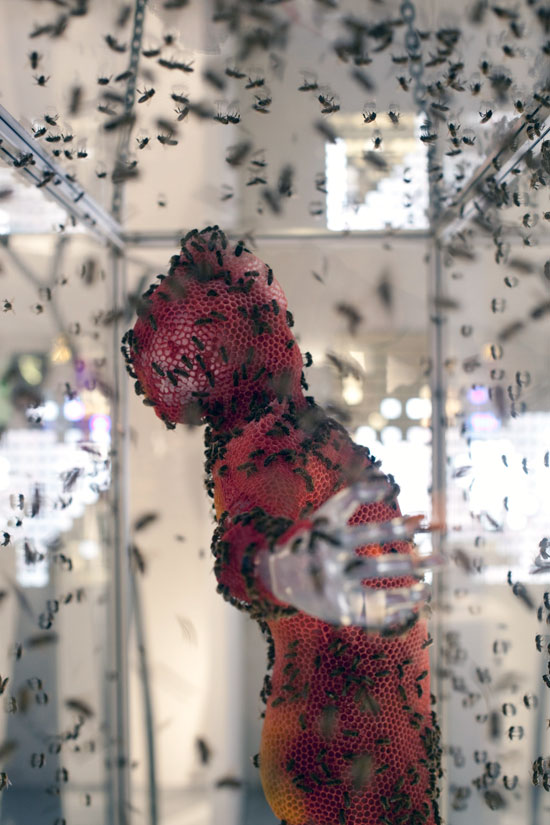
bees hard at work on the figure of the martyred christ
image courtesy of carpenters workshop gallery
I am not a huge fan of conceptual art. However, this piece fascinated me, not in its concept...blah blah blah religion and its endlessly toiling followers...blah blah blah, but in the mechanics of its construction. Somehow the artist got these bees to build their comb on a human shaped armature, fill it with honey and then empty the honey back out into their own hive. I would like to see some images of the piece in process. Was it made in the gallery? If so, how the heck did he make it so the bees could forage for the materials to build comb over the human form in the vitrine? Does the artist have beekeeping experience? So many questions.
From DesignBoom
June 22, 2010
tomas gabzdil libertiny: unbearable lightness
'unbearable lightness'
125 x 125 x 48 cm
in an edition of 6 + 2AP"
During design miami / basel 2010, carpenters workshop gallery (london) presented 'unbearable lightness' by dutch designer tomáš gabzdil libertiny. suspended on four chains and a hook, the small cabinet is a clean-room unit that has been built from custom aluminium profiles, glass sheets and plastic inserts, elements which are typically used in the automation industry.
For this specific event, the base plate of the glass was cut with a queen restrictor mesh. Over the course of the fair, 40 000 worker bees were released into the case to complete a wax honeycomb structure over the figure of a martyred christ rising out of the chaos, his weight seeming to be upheld by the mass strength of the swarm. the artist managed to gain complete control over the bees and lure them to construct their hive precisely over the figure within the vitrine that is made of a laser sintered framework. the industrious bees created a honeycomb skin over the figure before filling each cell with the honey they produce. then bees worked to remove the honey from the cells and return it to the beehive, cleaning the martyred christ back to the wax cells they originally created.

image courtesy of carpenters workshop gallery

bees hard at work
image courtesy of carpenters workshop gallery
Libertiny's allegory engages us with his desire to manipulate and control a social wild-life entity as the means to fulfilling the final product. here the bees,
engaging in their repetitive natural process while unknowingly creating the world's most recognized religious effigy. the suspended closed cabinet references the strict boundaries of society where the toil of everyday duty is masked by the hope of eternal rest in an after-life promised by the believer. the bees are programmed to act for their queen who puppet-rules for libertiny. the viewer is able to recognize this element of manipulation of the bees while ignorant to the invisible constraints and measures imposed on our own existence. initially, tomáš introduced a natural red pigment into the mold which bees spread evenly across the whole figure. the red relates to blood and flesh and is also the only color in the visible spectrum that bees do not see."
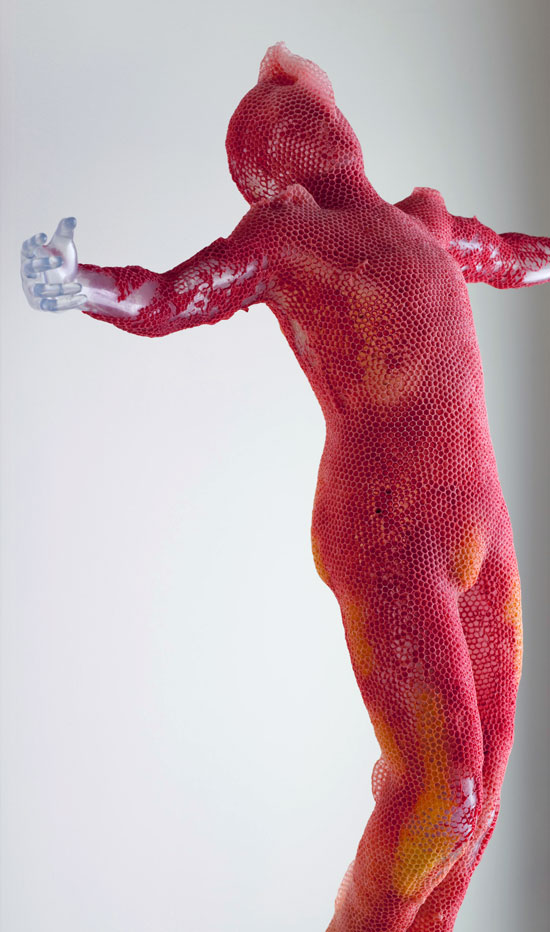
the honeycomb skin the bees created
image courtesy of carpenters workshop gallery
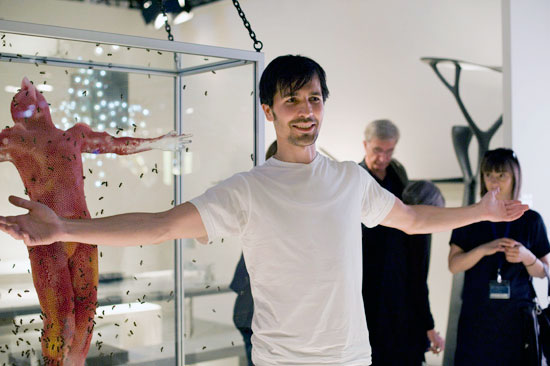
designer tomáš gabzdil libertiny
image courtesy of design miami / basel
image courtesy of carpenters workshop gallery
Subscribe to:
Posts (Atom)
